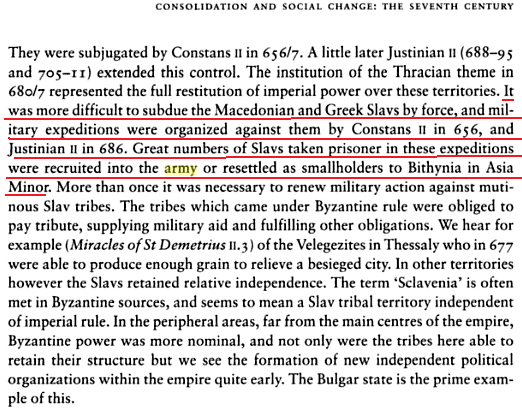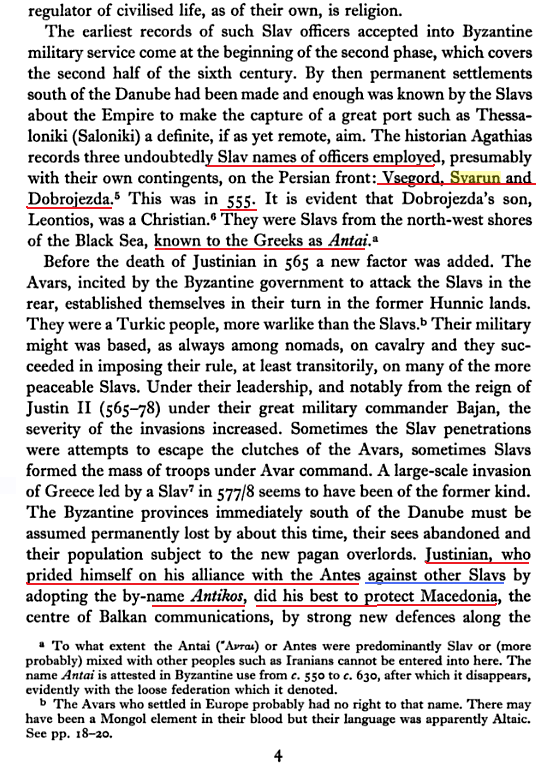I will start with a post from another thread, to provide a background for this topic and the below events.
Prior to the events of Thomas the Slav, a battle took place between the empires of East Rome and Bulgaria that engaged the Macedonians in battle.
The territory covered by the Macedonia Theme has since ancient times been a meeting point of Macedonians and Thracians that were loyal to the Macedonian Kingdom. The below text by George Finlay elaborates a little more on the same event:
The native people of both Macedonia proper and the Macedonia Theme spoke a Slavonic tongue, and their distinction, particularly as soldiers, was proven in East Rome, Bulgaria and Serbia. Since the creation of the Macedonia Theme, the mix of Slavonic tribes, Macedonians and Thracians came to represent a powerful element in East Rome, centred around their capital Adrianople (Odrin). In addition to the example already cited regarding the Macedonian and Thracian troops that fought for East Rome against Bulgaria, some decades later, the same powerful combination was used to subdue the Slavonic rebels in the Peloponnese. Below is an excerpt from De Administrando Imperio, that cites an event that took place during the regency of Michael III (842-867)
Macedonia proper was under the control of Slavonic-speaking rebels as the above events unfolded, although the local population had since the second half of the 8th century been less rebellious towards East Rome. Bulgaria too, had increased its appeal, as with each year passing the Slavonic element in the local language prevailed completely over the tongue of the ruling class of Asian Bulgars and the official state tongue, which was Greek until then. With the baptism of Boris, and subsequently his subjects in Moesia (where the Bulgarian Kingdom was based), Macedonia proper was gradually absorbed into Bulgaria either by agreement or subjugation, which cemented the language and Christian faith in Boris' realm (led previously by Turkic Bulgars).
TrueMacedonian, I see that you have posted information on Aplakes elsewhere, good information, if you have anything further to add in relation to the above, please do so.
The fact that the Macedonia Theme was established well over 2 centuries after the invasion of the Slavic-speaking tribes from the Danube indicates that the local Macedonian populace and the relevant Slavic tribes lived in relative harmony after the initial turbulence. The Macedonia Theme included large parts of southern Thrace covering lands from the Sea of Marmara to the city of Adrianople, which was chosen as its capital, and was governed as a single administrative unit. Macedonia proper was not included in the new East Roman administrative unit as control of the region could not be guaranteed due to the rebellious inhabitants who had maintained their autonomous status. Segments of the Macedonian nobility who wished to avoid any further involvement in the rebellious attacks against the East Romans, and/or to avoid the impending Bulgar attacks and invasions, had much to lose with the breakdown of the East Roman system. A gravitation east towards the capital by way of partial Macedonian emigration appears to have taken place, inspiring the name of the Macedonia Theme.
Although the Slavic rebels of Macedonia spent time to recover from recent battles against the East Romans, the Slavic tribes of the Peloponnese erupted in revolt, turning on the East Roman establishment and in particularly their Greek-speaking neighbours. In the year 821, an individual known as Thomas, who was a Slavic-speaking soldier in the East Roman Army, had raised the banner of revolt in the Asia Minor provinces. Emperor Michael II was in a dire position as East Roman rule diminished in all the eastern provinces except Opsikion and Armeniakon, with Thomas actually being crowned as an emperor by the Patriarch of Antioch, also receiving support by the local Muslims hostile towards the East Romans. Eventually Emperor Michael II utilised the help of the Bulgar Khan Omurtag, who intervened in the civil war on behalf of the East Romans. Although Thomas the Slav had amassed a large army and territory within a relatively short period of time, not doubt including several thousand descendants of the Slavic-speaking rebels from Macedonia that were resettled in Asia Minor, and had spent over a year attempting to take Constantinople via siege, he was captured and killed in the year 823. The main reasons for the revolt led by Thomas the Slav was to support the “iconodules” during the Iconism struggles and also to stand up for the poor who were being bled dry by the East Roman system.
Although the Slavic rebels of Macedonia spent time to recover from recent battles against the East Romans, the Slavic tribes of the Peloponnese erupted in revolt, turning on the East Roman establishment and in particularly their Greek-speaking neighbours. In the year 821, an individual known as Thomas, who was a Slavic-speaking soldier in the East Roman Army, had raised the banner of revolt in the Asia Minor provinces. Emperor Michael II was in a dire position as East Roman rule diminished in all the eastern provinces except Opsikion and Armeniakon, with Thomas actually being crowned as an emperor by the Patriarch of Antioch, also receiving support by the local Muslims hostile towards the East Romans. Eventually Emperor Michael II utilised the help of the Bulgar Khan Omurtag, who intervened in the civil war on behalf of the East Romans. Although Thomas the Slav had amassed a large army and territory within a relatively short period of time, not doubt including several thousand descendants of the Slavic-speaking rebels from Macedonia that were resettled in Asia Minor, and had spent over a year attempting to take Constantinople via siege, he was captured and killed in the year 823. The main reasons for the revolt led by Thomas the Slav was to support the “iconodules” during the Iconism struggles and also to stand up for the poor who were being bled dry by the East Roman system.
On 5 November 812 Mesembria fell. It was now clear to Michael that he must march once more against his adversary; and this time he must win. All that winter he spent gathering his troops, from every corner of the Empire; and in May 813 he set out. The following month, on the field of Versinicia near Adrianople, the armies came face to face; and on 22 June John Aplakes, commander of the Macedonians on the left wing, led his men into the attack. The Bulgars fell back in confusion, and for a moment it looked as if the battle were over almost before it had begun. But then an astonishing thing happened: the Anatolian troops on the right, commanded by an Armenian named Leo, suddenly turned tail and fled from the field. At first, we are told, Krum stood incredulous; then he and his men fell on the luckless Macedonians and slaughtered them wholesale. ---- A Short History of Byzantium (Based on the Great Three-Volume Work)” by John Julius Norwich, page 126.
In the month of May, Michael again resumed the command of the army, but instead of listening to the advice of the experienced generals who commanded the troops, he allowed himself to be guided by civilians and priests, or by the suggestions of his own timidity. There were at the time three able officers in the army — Leo the Armenian, the general of the Anatolic theme ; Michael the Amorian, who commanded one wing of the army; and John Aplakes, the general of the Macedonian troops. Leo and Aplakes urged the emperor to attack the Bulgarians ; but the Amorian, who was intriguing against Theoctistos the master of the palace, seems to have been disinclined to serve the emperor with sincerity. The Bulgarians were encamped at Bersinikia, about thirty miles from the Byzantine army; and Michael, after changing his plans more than once, resolved at last to risk a battle. Aplakes, who commanded the Macedonian and Thracian troops, consisting chiefly of hardy Sclavonian recruits, defeated the Bulgarian division opposed to him; but a panic seized a part of the Byzantine army; and Leo, with the Asiatic troops, was accused of allowing Aplakes to be surrounded and slain, when he might have saved him.
....and in the reign of Michael, the son of Theophilus, the protospatharius Theoctistus, surnamed Bryennius, was sent as military governor to the Province of Peloponnesus with a great power and force, viz., of Thracians and Macedonians and the rest of the western provinces, to war upon and subdue them. He subdued and mastered all the Slavs and other insubordinates of the province of Peloponnesus, and only the Ezeritai and the Milingoi were left, towards Lacedaemonia and Helos…….
TrueMacedonian, I see that you have posted information on Aplakes elsewhere, good information, if you have anything further to add in relation to the above, please do so.







Comment